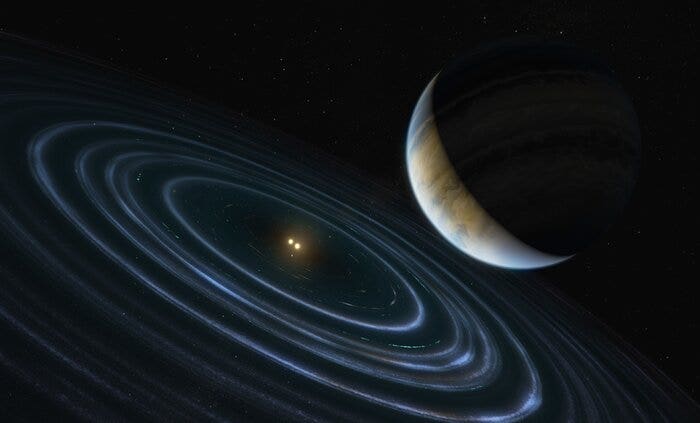
Dec. 21 marks the winter solstice, the shortest day of the year in the northern hemisphere and the start of astronomical winter. This year's winter solstice will be a bit special, though, with the darkness punctuated by a rare planetary conjunction.
Jupiter and Saturn will rendezvous in the night sky on Monday and may appear joined as one "double planet." It's been nearly eight centuries since the pair of planets appeared this close together in the night sky. In 1623, a similar conjunction of the planets occurred, but on the same side of the sky as the sun; that meant the conjunction wasn't visible from Earth.
And here's another article:
Mysterious Planet Nine discovery may be forthcoming after bizarre exoplanet found in deep space |

Although scientists have yet to find the elusive Planet 9, a recently discovered exoplanet in deep space may provide further evidence the mysterious celestial object indeed exists.
The exoplanet HD 106906 b is 336 light years from Earth and has a bizarre orbit around its pair of host stars, going around once every 15,000 years, according to a study published in The Astronomical Journal .
First discovered in 2013, the exoplanet is massive, at 11 times the size of Jupiter . Yet, it was only recently, thanks to measurements from the Hubble Space Telescope, that scientists were able to see its elongated -- 730 times the distance between the Earth and the sun -- and inclined orbit, unlike any of the known planets in the Solar System.
Mars lander spies the planet's deep boundaries | Science

For 2 years, NASA's InSight spacecraft has been on the surface of Mars, spending much of that time listening with sensitive seismometers for marsquakes to glean the planet's internal structure, and the processes that in turn formed it. That hunt has been harder than hoped, because of howling winds, defiant martian soil, and a mysterious absence of large marsquakes that could easily be located by the spacecraft.
Scientist believe they've detected mysterious radio signal from alien planet

According to Meghan Bartels with Space.com, astronomers' research led them to uncovering a particularly interesting radio signal coming from a star system named Tau Boötes that has at least one exoplanet.
* * *
Scientists think they've detected radio emissions from an alien world https://t.co/JqXXI35qZG pic.twitter.com/JHTPNNcIvQ
"We present one of the first hints of detecting an exoplanet in the radio realm," Jake Turner, an astronomer at Cornell University told the Cornell Chronicle's Blaine Friedlander .
Quite a lot has been going on:
Discovery of exoplanet's bizarre orbit may help us track down Planet Nine - BBC Science Focus

Since 2014, scientists have debated whether the elusive Planet Nine really exists, as its proposed orbit is so different from the eight planets we know. It is thought that Planet Nine travels round the Sun with a highly elliptical motion. Now, a team of astronomers have provided evidence that the theorised orbit of Planet Nine exists for an exoplanet elsewhere in the Universe.
Analysing 14 years of data from NASA's Hubble Space Telescope , researchers led by Meiji Nguyen of the University of California, Berkeley, showed that such an elliptical orbit exists in an exoplanet , a planet outside of our Solar System , called HD 106906 b. Granted, it's not the catchiest of names but this exoplanet's observations could change our understanding of our Solar System and the beginning of the Universe.
Rare 'Christmas Star' will appear next week as planets align
BATON ROUGE – A bright sight that hasn't been seen since the middle ages will be happening again Monday, right in time for the Christmas holiday. Saturn and Jupiter’s orbits will be aligning putting them the closest planets have been in 800 years.
“It will look like a very bright object in the sky. It won’t look like a star in the sense of twinkling, because they are planets. But, they will have to be separated by a binocular. That’s how close they’ll be,” said Chris Kersey, the manager at the Highland Park Road Observatory.
Planet-nine analog exoplanet orbits a double star system | Popular Science

Astronomers Have Found Planet 9... in Another Solar System - Universe Today

Even with all we’ve learned about our own Solar System, especially in the last couple of decades, researchers still face many unanswered questions. One of those questions regards the so-called Planet Nine . The Planet Nine hypothesis states that there’s a massive planet in our Solar System orbiting at a great distance from the Sun.
Nobody’s ever observed the hypothesized planet; the evidence for it lies in a cluster of bodies that orbit the Sun 250 times further out than Earth does. These objects are called e-TNOs, for extreme Trans-Neptunian Objects . According to the hypothesis, Planet Nine’s gravity is responsible for the unusual clustered orbits of these e-TNOs.
Happening on Twitter
You're in for a treat if you look up at the night sky. Jupiter & Saturn have been getting closer and will 'kiss'… https://t.co/axqQEaYk0B SimonOKing (from BBC North) Fri Dec 18 09:11:17 +0000 2020
#TheMandalorian made me fall in love with Star Wars all over again. What an incredible two seasons it's been. I wi… https://t.co/OB7XUjwwpl SimuLiu (from Toronto/Los Angeles) Fri Dec 18 11:13:10 +0000 2020
Saturn and Jupiter are coming closer together than they have been since the Middle Ages, and it's happening just in… https://t.co/YpLL9uDGxW CNN Thu Dec 17 11:16:06 +0000 2020

No comments:
Post a Comment